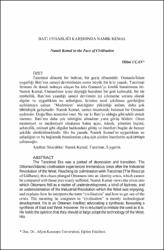Batı Uygarlığı Karşısında Namık Kemal
Özet
Tanzimat dönemi bir buhran, bir geçiş dönemidir. Osmanlı/İslam
uygarlığı Batı’nın sanayi devriminden sonra büyük bir kriz yaşadı. Tanzimat
fermanı ile doruk noktaya ulaşan bu kriz Osmanlı’yı kimlik bunalımına itti.
Namık Kemal, Osmanlının içine düştüğü bunalımı bir geri kalmışlık, bir tür
tembellik, Batı’nın yaşadığı sanayi devrimini iyi izlememe sorunu olarak
algılar ve uygarlıktan ne anladığını, krizden nasıl çıkılması gerektiğini
açıklamaya çalışır. ‘Medeniyet’ sözcüğüne yüklediği anlam, daha çok
teknolojik gelişmedir. Namık Kemal, sentez önerisinde bulunan bir Osmanlı
aydınıdır. Doğu/Batı sentezini ister. Ne var ki Batı’yı olduğu gibi taklit
etmek istemez. Batı’nın daha çok tekniğini almaktan yana görüş bildirir.
Onun medeniyet ve medeniyeti oluşturan bakış açısı, teknik, yönetim biçimi,
şehircilik, mimari gibi olgular hakkındaki görüş ve önerileri bugün de benzer
şekilde sürdürülmektedir. Biz bu yazıda, Namık Kemal’in uygarlıktan ne
anladığını ve bu bağlamda bunalımdan çıkış için çözüm önerilerini
açıklamaya çalışacağız. The Tanzimat Era was a period of depression and transition. The
Ottoman/Islamic civilisation experienced tremendous crisis after the
Industrial Revolution of the West. Reaching its culmination with Tanzimat
(The Rescript of Gülhane), this chaos plunged Ottomans into an identity
crisis, which cannot be compared with those previously suffered. Namık
Kemal views the crisis into which Ottomans fell as a matter of
underdevelopment, a kind of laziness, and an underestimation of the
Industrial Revolution which the West was enjoying, and explains how he
interprets the term “civilisation” and how to get out of the crisis. The
meaning he assignees to “civilisation” is mostly technological development.
He is an Ottoman intellect advocating a synthesis; favouring a synthesis of
East and West. However, he is reluctant to imitate the west as it is. He holds
the opinion that they should at large adopt the technology of the West. His opinions about civilisation and its pillars, as well as his ideas and proposals
about key concepts like technology; government, urban planning, and
architecture are similarly maintained today. This article seeks to describe
Namık Kemal’s interpretation of “civilisation” and, within this context, his
resolutions for finding an outlet out of this depression.



















